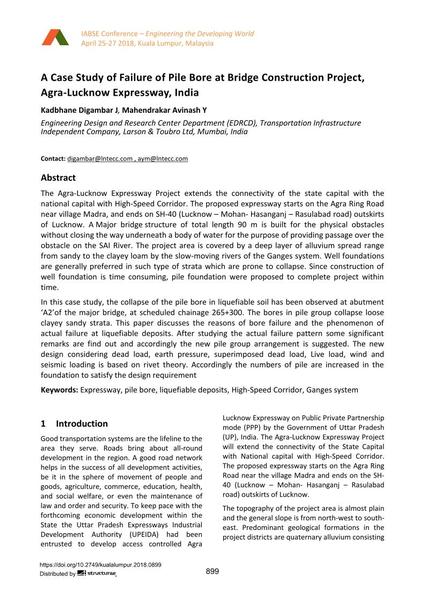A Case Study of Failure of Pile Bore at Bridge Construction Project, Agra-Lucknow Expressway, India

|
|
|||||||||||
Bibliographic Details
| Author(s): |
Digambar J. Kadbhane
(Engineering Design and Research Center Department (EDRCD), Transportation Infrastructure Independent Company, Larson & Toubro Ltd, Mumbai, India)
Avinash Y. Mahendrakar (Engineering Design and Research Center Department (EDRCD), Transportation Infrastructure Independent Company, Larson & Toubro Ltd, Mumbai, India) |
||||
|---|---|---|---|---|---|
| Medium: | conference paper | ||||
| Language(s): | English | ||||
| Conference: | IABSE Conference: Engineering the Developing World, Kuala Lumpur, Malaysia, 25-27 April 2018 | ||||
| Published in: | IABSE Conference Kuala Lumpur 2018 | ||||
|
|||||
| Page(s): | 899-904 | ||||
| Total no. of pages: | 6 | ||||
| DOI: | 10.2749/kualalumpur.2018.0899 | ||||
| Abstract: |
The Agra-Lucknow Expressway Project extends the connectivity of the state capital with the national capital with High-Speed Corridor. The proposed expressway starts on the Agra Ring Road near village Madra, and ends on SH-40 (Lucknow – Mohan- Hasanganj – Rasulabad road) outskirts of Lucknow. A Major bridge structure of total length 90 m is built for the physical obstacles without closing the way underneath a body of water for the purpose of providing passage over the obstacle on the SAI River. The project area is covered by a deep layer of alluvium spread range from sandy to the clayey loam by the slow-moving rivers of the Ganges system. Well foundations are generally preferred in such type of strata which are prone to collapse. Since construction of well foundation is time consuming, pile foundation were proposed to complete project within time. In this case study, the collapse of the pile bore in liquefiable soil has been observed at abutment ‘A2’of the major bridge, at scheduled chainage 265+300. The bores in pile group collapse loose clayey sandy strata. This paper discusses the reasons of bore failure and the phenomenon of actual failure at liquefiable deposits. After studying the actual failure pattern some significant remarks are find out and accordingly the new pile group arrangement is suggested. The new design considering dead load, earth pressure, superimposed dead load, Live load, wind and seismic loading is based on rivet theory. Accordingly the numbers of pile are increased in the foundation to satisfy the design requirement |
||||
| Keywords: |
expressway pile bore liquefiable deposits High-Speed Corridor Ganges system
|
||||
